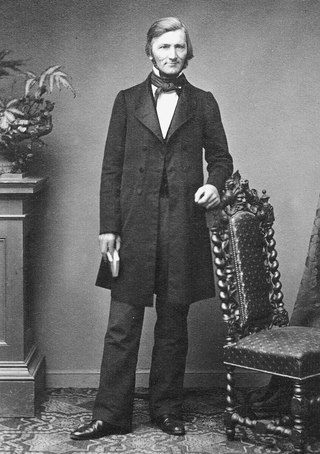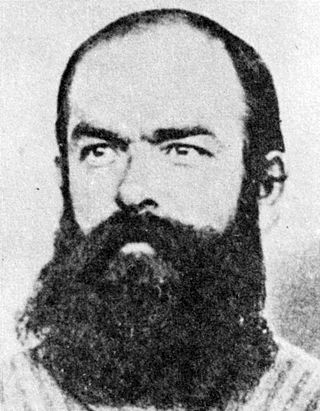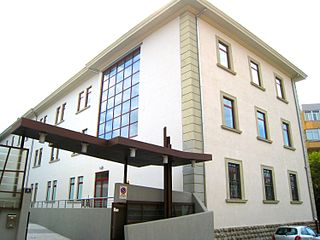Related Research Articles

Karel Johan Gustav Hartlaub was a German physician and ornithologist.

Oswald Heer, Swiss geologist and naturalist, was born at Niederuzwil in Canton of St. Gallen and died in Lausanne.
Maximilian Spinola was an Italian entomologist.

The Museum of Zoology and Natural History, best known as La Specola, is an eclectic natural history museum in Florence, central Italy, located next to the Pitti Palace. The name Specola means observatory, a reference to the astronomical observatory founded there in 1790. It now forms part of the Museo di Storia Naturale di Firenze. This museum is part of what are now six different collections at four different sites for the Museo di Storia Naturale di Firenze.

Mario Bezzi was an Italian professor of zoology at the University of Turin. He was also director of the Turin Museum of Natural History. He was a Doctor of Science.

John Stanislaw Kubary also stated as Jan Stanisław Kubary, Jan Kubary, or Johann Stanislaus Kubary, was a Polish naturalist and ethnographer.

Giorgio Jan was an Italian taxonomist, zoologist, botanist, herpetologist, and writer. He is also known as Georg Jan or Georges Jan. He was the first director of the natural history museum at Milan.

Filippo Silvestri was an Italian entomologist. He specialised in world Protura, Thysanura, Diplura and Isoptera, but also worked on Hymenoptera, Myriapoda and Italian Diptera. He is also noted for describing and naming the previously unknown order Zoraptera. In 1938 he was nominated to the Pontifical Academy of Sciences, the scientific academy of the Vatican.

Civico Museo di Storia Naturale di Trieste is a natural history museum in Trieste, northern Italy. It contains several collections, including more than two millions botanical, zoological, mineralogical, geological, and paleontological specimens.

The Museum Godeffroy was a museum in Hamburg, Germany, which existed from 1861 to 1885.
Fritz Rühl, also Roule, was a Swiss entomologist. He was a professional insect collector and insect dealer who worked with the Berlin natural history dealers and publishers Alexander Heyne and Otto Staudinger. His Hymenoptera collections were sold to Paolo Magretti and are conserved in the Museo Civico di Storia Naturale di Genova. He supplied collections of Lepidoptera and Coleoptera from around the world to the Istituto Sperimentale per la Zoologia Agraria in Florence.

The Castellieri culture developed in Istria during the Early and Middle Bronze Age, and later expanded into Friuli, Dalmatia and the neighbouring areas. It lasted for more than a millennium, from the 18th century BC until the Roman conquest in the 3rd century BC. It takes its name from the fortified settlements, Castellieri, which characterized the culture. The term was coined by Carlo Marchesetti.

Johann Cesar Godeffroy was a German trader, blackbirder and Hanseat.
Christian Luerssen was a German botanist. He was an authority in the field of pteridology.
Macrocoma fuscoaenea is a species of leaf beetle found in Ethiopia, Tanzania and the Democratic Republic of the Congo. It was first described by Félicien Chapuis in 1879.

Hedana is a genus of crab spiders that was first described by Ludwig Carl Christian Koch in 1874.
Antonio Giordani Soika was an Italian entomologist, ecologist and director of the Civic Museum of Natural History of Venice. He had a long career in which he worked on various groups of insects but much of his work was on the Hymenoptera. He made great contributions to the knowledge of Neotropical wasps, especially potter wasps for which he produced many taxonomic keys and also monographs on the systematics of the wasp family Vespidae.

The Obrimini are the most species-rich tribe of the Phasmatodea family of the Heteropterygidae native to Southeast Asia.
References
- Alberti, G. Uomini e Insetti; La collezioni del Museo Civico di Storia Naturale de Trieste e la loro Storia. Trieste, Museo Civico di Storia Naturale : 1-54 5-54
- Conci, C. & Poggi, R. 1996 Iconography of Italian Entomologists, with essential biographical data. Mem. Soc. Ent. Ital. 75 159-382, 418 Fig. 159-382
- ↑ Discovery of Australia's Fishes A History of Australian Ichthyology to 1930 by Brian Saunders
- 1 2 Collectors Index Herbarium Lichen herbaria
- ↑ Note: The museum contained insects from Australia, Samoa, Fiji, Tonga, the Phoenix Islands etc., and also functioned as a dealership in natural history material.
- ↑ Reisen im Inneren der Insel Viti-Levu Archived 2013-10-20 at the Wayback Machine Neujahrsblatt der Naturforschenden Gesellschaft in Zürich auf das Jahr 1868, Nr. 70.
- ↑ Google Books Collected Papers by Charles Atwood Kofoid
- ↑ Avibase Fiji Whistler (Pachycephala graeffii)
- ↑ Helm dictionary of scientific bird names - SlideShare Archived 2015-11-19 at the Wayback Machine
- ↑ Lexikon deutschsprachiger Bryologen. [Hauptbd.], Volume 1 by JanPeter Frahm, Jens Eggers
- ↑ Google Books Contributo alla Fauna dei Ditteri dei dintorni di Trieste
- ↑ Beiträge zur Hymenopterenfauna Dalmatiens, Montenegros und Albaniens
- ↑ WorldCat Search (publications)
- ↑ Google Books (publications)